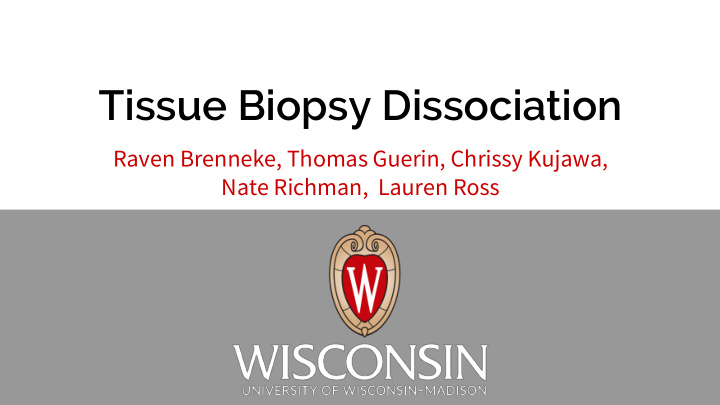



Tissue Biopsy Dissociation Raven Brenneke, Thomas Guerin, Chrissy Kujawa, Nate Richman, Lauren Ross
Overview Problem Statement ● Background ● PDS ● Review of Last Semester ● Designs ● Fabrication Matrix ● Preliminary Testing ● Future Work ● Acknowledgments ●
Problem Statement Dr. Sameer Mathur conducts asthma research and frequently obtains small lung tissue biopsies from patients Current device being used for tissue dissociation are designed for larger scale specimens of tissue Small biopsies are not compatible with this device-cells do not dissociate The team’s task: develop a smaller scale device to successfully dissociate a smaller tissue specimen
Asthma & Lung Biopsies What is asthma caused by? ● Airborne allergens Inflammatory response led by T-helper type lymphocytes 1 ● How are lung biopsies performed? Needle, thoracoscopic, transbronchial, open 2 ● ● Client does bronchoscopies ● Fiber optic bronchoscope through airways ● 1-2 mm tissue
Product Design Specifications Yield at least 10,000 cells ● Preferably 10,000 eosinophils ○ Needs to process tissue sizes of 1-2mm 3 ● Material for the device must be less than $10 per run ● Materials used and process should not lyse cells or disrupt cell markers ●
Review of last semester
Competing/Informing Designs Microfluidic device for dissociation of tumor aggregates 3 Miltenyi gentleMACS 5 Microfluidic device for dissociation of neurons 4
Design Programmable peristaltic pump
Fabrication Methods 3D printing PDMS Laser Micromilling Photolithography Cutting
PDMS Category Winner Criteria 3D Printing Laser Cutting Micromilling Photolithography Matrix Winner Accuracy 28 (4/5) 21 (3/5) 21 (3/5) 35 (5/5) (35) Materials 18 (3/5) 30 (5/5) 24 (4/5) 30 (5/5) (30) Ease of Fabrication 20 (5/5) 12 (3/5) 12 (3/5) 8 (2/5) (20) Cost 12 (4/5) 12 (4/5) 15 (5/5) 3 (1/5) (15) Total 78 75 72 76 (100)
Preliminary Testing 1. Take frozen mouse lung tissue and use biopsy tool to create 2mm sample 2. Incubate in collagenase solution for 30 min. at 37C 3. Place tissue in device 4. Seal device using clamps 5. Run HBSS through device 5 times using peristaltic pump 6. Spin down solution in centrifuge 7. Resuspend cells 8. Count cells
Preliminary Testing
Future Work Overall goal of this semester: Achieve complete tissue dissociation ● Create a better system of sealing the top ○ Eliminate leaking issues ○ Possibly have closed system ○ Cell count ○ Change channel size/length ○ Future semester(s) ● Cell viability/cytotoxicity ○ Professional fabrication ○
Acknowledgements Dr. Sameer Mathur Dr. Krishanu Saha Robert Swader Elizabeth McKernan
Questions?
References [1] J. R. Murdoch and C. M. Lloyd, “Chronic inflammation and asthma,” Mutation Research , 07-Aug-2010. [Online]. Available: https://www.ncbi.nlm.nih.gov/pmc/articles/PMC2923754/. [Accessed: 05-Oct-2017]. [2] “Lung Biopsy,” Lung Biopsy | Johns Hopkins Medicine Health Library . [Online]. Available: http://www.hopkinsmedicine.org/healthlibrary/test_procedures/pulmonary/lung_biopsy_92,P07750. [Accessed: 05-Oct-2017]. [3] Dr. R-P. Peters, Dr. E. Kabaha, W. Stoters, G. Winkelmayer and F. Bucher, “Device for fragmenting tissue,” European Patent Specification #EP2540394B1, May 05th, 2016 [4] L. Jiang, R. Kraft, L. Restifo et al. “ Dissociation of brain tissue into viable single neurons in a microfluidic device,” [Online] Available: http://ieeexplore.ieee.org/document/7492500/. [Accessed: 21-Feb-2018]. [5] Miltenyi Biotec, “GentleMACS Dissociator,” Jan. 1, 2018.
Recommend
More recommend